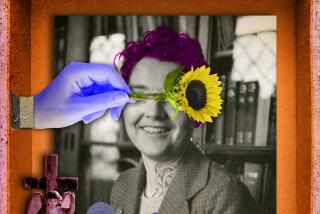Her Fate in His Revolution : EVA LUNA <i> by Isabel Allende; translated from the Spanish by Margaret Sayers Peden (Alfred A. Knopf: $18.95; 272 pp.; 0-394-57273-4) </i>
This novel is a striking departure for Isabel Allende: not the well-heeled clan of “The House of Spirits,” nor the declining gentry of “Of Love and Shadows,” but a lone girl’s childhood and coming of age. Eva Luna knows her father only as legend; her mother dies when Eva is only 6 years old, leaving her in the hands of a succession of caretakers who nourish and encourage her. It is a picaresque tale of a South American child who likes to tell stories and who grows up to write novels.
“My imagination took wing when I saw that corridor of locked doors,” Eva writes, “behind every one I thought I heard whispers, moans, laughter. At first I put my ear to the doors and peeked through the keyholes, but soon I found I did not have to do that to divine the universes hidden there. . . . It took only the slightest effort of imagination to pass through the door and enter the extraordinary stories unfolding on the other side of the walls.”
Eva’s introduction to politics comes from Huberto Naranjo, a 9-year-old boy who lives on his own and who meets Eva when she first runs away from her housekeeping job. “At 16 he would be the leader of a street gang, feared and respected . . . he would be the hero of the whores in the red-light district, and the nightmare of the guardia. “ With his help, Eva lives for some time at the home of one of his friends, a Madam (La Senora) who is forced to flee when the military cracks down on the red-light district.
The caretaker who changes Eva’s life is Riad Halabi, who finds her on the street during the tumultuous days of the Revolt of the Whores. The compassionate Arab shopowner adopts Eva--and hires a teacher to instruct her to read and write.
Allende’s descriptions of Eva’s burgeoning writing talents are enormously moving, and the reader will wonder to what degree they are autobiographical. “Writing was the best thing that had happened to me in all my life; I was euphoric,” Eva writes. “I read aloud, and walked around with my notebook tucked under my arm so I could use it at any moment; I jotted down thoughts, the names of flowers, birdcalls; I made up words.”
Years later Eva recounts her own life story: “Characters stepped from the shadows where they had been hidden for years into the light . . . each with a face, a voice, passions, and obsessions. . . . I recalled the tales my mother told me when we were living among the Professor’s idiots, cancer patients, and mummies; a snake-bitten Indian appeared, and a tyrant with hands devoured by leprosy; I rescued an old maid who had been scalped as if by a spinning machine, a dignitary in a purple plush chair, an Arab with a generous heart. . . . Little by little, the past was transformed into the present, and the future was also mine.”
Eva re-encounters Huberto Naranjo now an adult--he has become the leader of a guerrilla movement, Comandante Rogelio--and she becomes his lover. But while she is seduced by his rhetoric and even collaborates in an attempt to free political prisoners, his world is exclusively a man’s turf, and Naranjo an “ingrained macho”: “He believed that because I had been born a girl I was at a disadvantage, I should accept my limitations and entrust myself to others’ care. . . . His revolution would not change my fate in any fundamental way; under any circumstances, as long as I lived I would still have to make my own way.”
When Allende focuses on Eva’s story she is on terra firma, but for reasons that are unclear, she shoehorns a major subplot--that of a young cameraman who ultimately will become Eva’s life companion. The result is a superfluity of incident, extraneous and intrusive, all in the service of an artificially neat ending.
Such qualifications aside, “Eva Luna” is an inventive and feverish political fable from one of South America’s most interesting writers.
More to Read
Sign up for our Book Club newsletter
Get the latest news, events and more from the Los Angeles Times Book Club, and help us get L.A. reading and talking.
You may occasionally receive promotional content from the Los Angeles Times.






